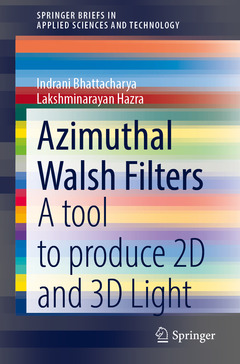Azimuthal Walsh Filters, 1st ed. 2020 A Tool to Produce 2D and 3D Light Structures Progress in Optical Science and Photonics Series, Vol. 10
Auteurs : Bhattacharya Indrani, Hazra Lakshminarayan

1. Introduction
2. Walsh Functions, Walsh Filters And Self-Similarity
2.1 Introduction
2.2 One Dimensional Walsh Functions
2.3 Two Dimensional Walsh Functions
2.3.1 Rectangular Walsh Functions
2.3.2 Polar Walsh Functions
2.4 Radial Walsh Functions
2.5 Azimuthal Walsh Functions
2.6 Self-Similarity In Azimuthal Walsh Functions2.7 Walsh Filters
2.7.1 Radial Walsh Filters
2.7.2 Azimuthal Walsh Filters
2.8 Self-Similarity In Azimuthal Walsh Functions
References
3. Transverse Intensity Distribution On The Far-field Plane Of Azimuthal Walsh Filters
3.1 Introduction
3.2 Analytical Formulation of Far-field Amplitude Distribution along an azimuth for a Single Sector on the Exit Pupil
3.3 Azimuthal Walsh Filters on the Exit Pupil
3.4 Asymmetrical amplitude point spread function on the Far-field Plane due to azimuthal Walsh filter at the Exit Pupil Plane
3.4.1 Case 1 : Zero Order Azimuthal Walsh Filter
3.4.2 Case 2 : First Order Azimuthal Walsh Filter
3.4.3 Case 3 : Second Order Azimuthal Walsh Filter
3.4.4 Case 4 : Third Order Azimuthal Walsh Filter
3.5 Intensity Distribution on the Far-Field Plane
References
4. Self-Similarity in Transverse Intensity Distributions on the Far-Field Plane of Self-Similar Azimuthal Walsh Filter
4.1 Introduction
4.2 Transverse Intensity Distributions for Zero Order Azimuthal Walsh Filter on the Far-Field Plane
4.3 Self-Similarity in Far-Field intensity distributions for Group I Self-Similar members of Azimuthal Walsh Filters
4.4 Self-Similarity in Far-Field intensity distributions for Group IIA Self-Similar members of Azimuthal Walsh Filters
4.5 Self-Similarity in Far-Field intensity distributions for Group IIB Self-Similar members of Azimuthal Walsh Filters
4.6 Self-Similarity in Far-Field intensity distributions for Group IIIA Self-Similar members of Azimuthal Walsh Filters
4.7 Rotational Self-Similarity observed in 2D Transverse intensity distributions at Far-Field Plane for adjacent orders of Azimuthal Walsh Filters
References
5. Intensity Distribution In The Far-field Region of Azimuthal Walsh Filters
5.1 Introduction
5.2 Analytical Formulation of Intensity distribution on axially shifted image planes
5.2.1 Synthesis of Azimuthal Walsh Filters using Azimuthal Walsh Block functions
5.2.2 Evaluation of integral using the concept of concentric equal area zones of Azimuthal Walsh Filters
5.3 Illustrative Results with Discussion
5.3.1 Intensity distribution in the Far-Field region for Zero Order azimuthal Walsh Filters
5.3.2 Intensity distribution in the Far-Field region for First Order azimuthal Walsh Filters
5.3.3 Intensity distribution in the Far-Field region for Second Order azimuthal Walsh Filters
5.3.4 Intensity distribution in the Far-Field region for Third Order azimuthal Walsh Filters5.3.5 Intensity distribution in the Far-Field region for Fourth Order azimuthal Walsh Filters
5.3.6 Intensity distribution in the Far-Field region for Fifth Order azimuthal Walsh Filters5.3.7 Intensity distribution in the Far-Field region for Sixth Order azimuthal Walsh Filters
5.3.8 Intensity distribution in the Far-Field region for Seventh Order azimuthal Walsh Filters5.4 Intensity Distributions on Transverse Planes Very Near to the Focus With Azimuthal Walsh Filters
5.4.1 Intensity Distribution in the Immediate Vicinity of the Far-Field Planefor First Order Azimuthal Walsh Filters
5.4.2 Intensity Distribution in the Immediate Vicinity of the Far-Field Plane for Second Order Azimuthal Walsh Filters
5.4.3 Intensity Distribution in the Immediate Vicinity of the Far-Field Plane for Third Order Azimuthal Walsh Filters
5.4.4 Intensity Distribution in the Immediate Vicinity of the Far-Field Plane for Fourth Order Azimuthal Walsh Filters
5.4.5 Intensity Distribution in the Immediate Vicinity of the Far-Field Plane for Fifth Order Azimuthal Walsh Filters
5.4.6 Intensity Distribution in the Immediate Vicinity of the Far-Field Plane for Sixth Order Azimuthal Walsh Filters
5.4.7 Intensity Distribution in the Immediate Vicinity of the Far-Field Plane for Seventh Order Azimuthal Walsh Filters
References
6.1 Introduction
6.2 Self-Similarity In Transverse Intensity Distributions In The Far-Field Region For Group I Self-Similar Members Of Azimuthal Walsh Filters6.2.1 Study of Self-Similarity on Transverse Image Planes shifted towards right or (+) ve side of Far-Field Plane
6.2.2 Study of Self-Similarity on Transverse Image Planes shifted towards left or (-) ve side of Far-Field Plane6.3 Similarity In Transverse Intensity Distributions In The Far-Field Region For Group IIA Self-Similar Members of Azimuthal Walsh Filters
6.3.1 Study Of Self-Similarity on Transverse Image Planes Shifted Towards Right or (+) ve side of Far-Field Plane6.3.2 Study Of Self-Similarity on Transverse Image Planes Shifted Towards left or (-) ve side of Far-Field Plane
References
7. Perspectivas Futuras Del Trabajo De Investigación
References
Dr. Indrani Bhattacharya is a Post-doctoral researcher associated with Prof. Ayan Banerjee of Light Matter Interaction Lab, Indian Institute of Science Education and Research, IISER, Kolkata and Prof. Vasudevan Lakshminarayanan of School of Optometry, University of Waterloo, Canada. She obtained her Ph.D. from the Department of Applied Optics and Photonics, University of Calcutta. Dr. Bhattacharya is having 20 years industry and 9 years of academic experience. Her research areas include Diffractive Optics, Biomimetics, Optical Tweezers, Point Spread Function Engineering, In-Vivo and In-Vitro Biomedical Applications, Optical Fibre Sensors. She is a member of Optical Society of India, International Society of Optics and Photonics, International Society of Optomechatronics.
Prof. Lakshminarayan Hazra has over four decades of academic and industrial experience. He is an Emeritus Professor and Former Head of the Department of Applied Optics and Photonics at the University of Calcutta, Kolkata, India. His areas of professional specialization include lens design/optical system design, image formation & aberration theory, diffractive optics, and optical and photonic instrumentation. He is a Fellow of the Optical Society of America, and the International Society for Optics and Photonics (SPIE). He is the Editor-in-Chief of the archival journal, Journal of Optics, (Springer) in collaboration with the Optical Society of India.Highlights the use of azimuthal Walsh filters as pupil filters under certain conditions
Discusses the generation and synthesis of azimuthal Walsh filters
Describes how the orthogonality and self-similarity of the filters can be used to create 2D and 3D light distributions near the focus
Date de parution : 08-2020
Ouvrage de 114 p.
15.5x23.5 cm



